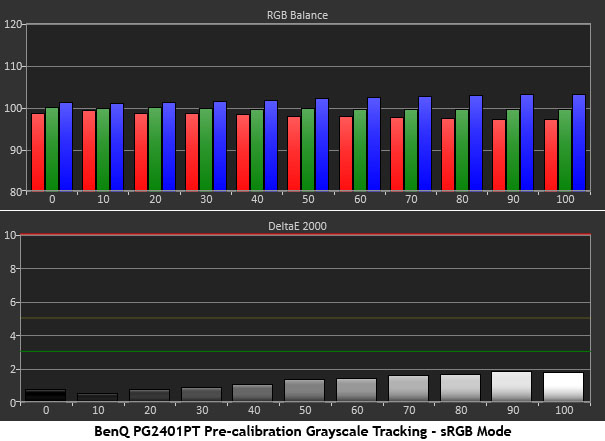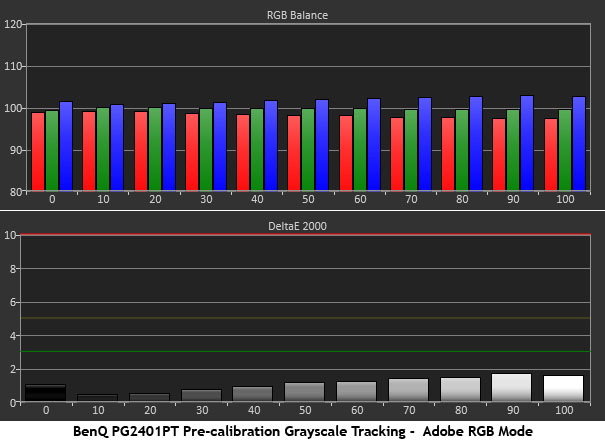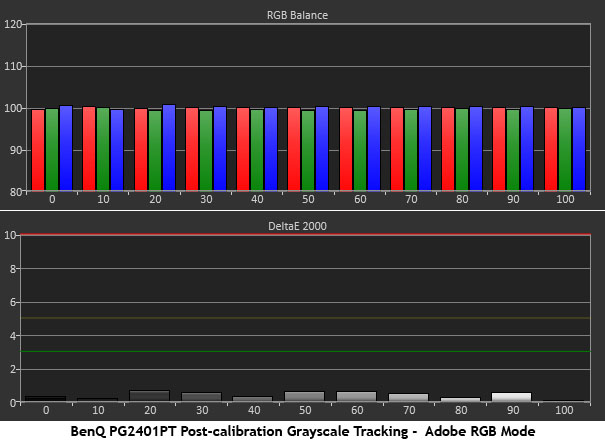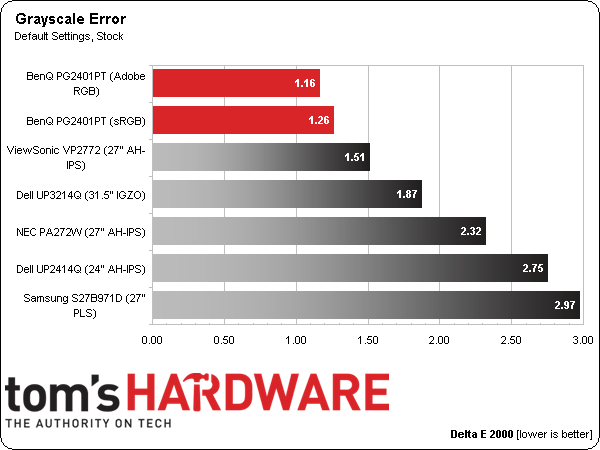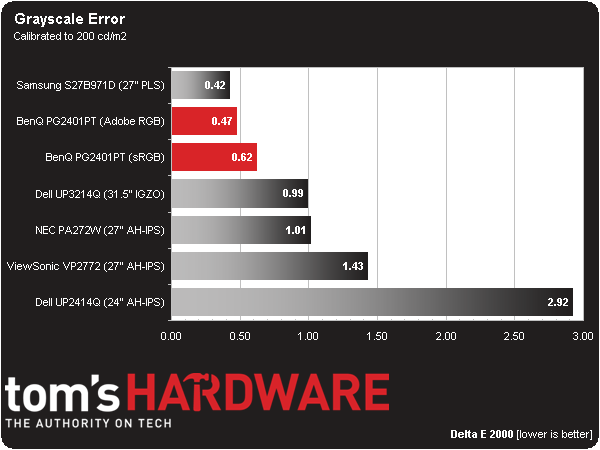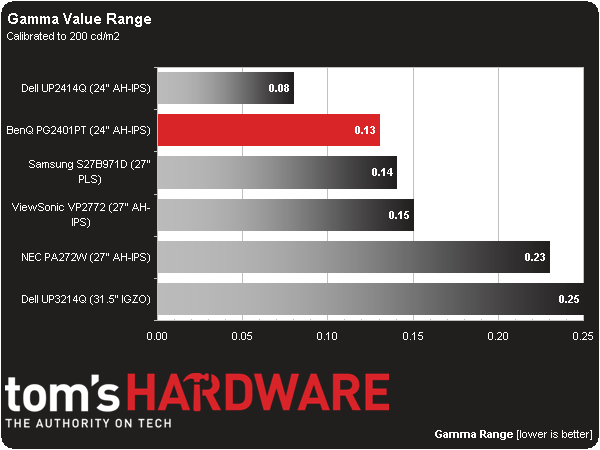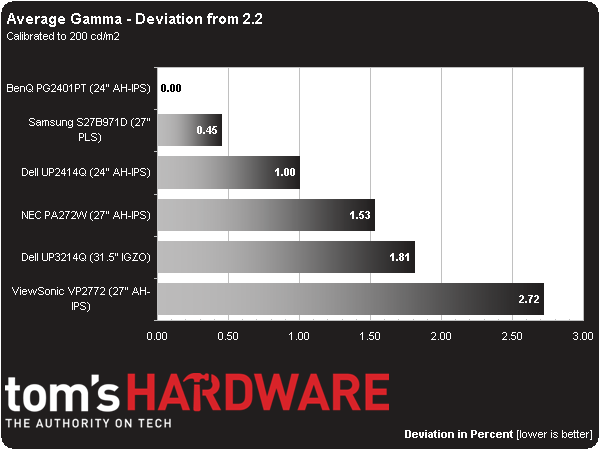BenQ PG2401PT, 24-inch Color Accurate Monitor Review
Photographers and printing pros look for the ultimate accuracy when they choose a monitor. BenQ answers the call with its 24-inch PG2401PT IPS display. It’s industry-certified for color accuracy, even without calibration. Today, we put it to the test.
Results: Grayscale Tracking And Gamma Response
The majority of monitors, especially newer models, display excellent grayscale tracking (even at stock settings). It’s important that the color of white be consistently neutral at all light levels from darkest to brightest. Grayscale performance impacts color accuracy with regard to the secondary colors: cyan, magenta, and yellow. Since computer monitors typically have no color or tint adjustment, accurate grayscale is key.
Given its color accuracy certification, the PG2401PT needs to be spot-on without user calibration. As you’ll see on the next two pages, BenQ easily earns itself a place among the most precise displays sold today.
Since most users will employ the preset sRGB and Adobe RGB modes, we measure those first.
It doesn’t get much better, with or without calibration. Nit-pickers like us will say the white point runs a tad cool, but with all errors under two Delta E, nobody will actually see a problem.
In Adobe RGB mode, the result is almost exactly the same. If you've read some of my other reviews of factory-calibrated monitors, then you know they typically don't measure this well out of the box.
To perform a calibration, we set up the two custom modes for sRGB and Adobe RGB, respectively. Our grayscale result was identical in both modes. For all intents and purposes, you are looking at perfection.
Here is our comparison group:
Get Tom's Hardware's best news and in-depth reviews, straight to your inbox.
These are the best Delta E numbers we’ve ever recorded for an un-calibrated display. With the exception of the ViewSonic (another $1000 screen), BenQ's PG2401PT is the least-costly monitor represented.
The S27B971D remains our calibrated grayscale champion by the slimmest of margins. With errors this low, it truly is a wash though. Since the BenQ offers an Adobe RGB gamut and superior color accuracy over the Samsung, a new value leader is emerging in the professional monitor category.
Gamma Response
Gamma is the measurement of luminance levels at every step in the brightness range from 0 to 100 percent. It's important because poor gamma can either crush detail at various points or wash it out, making the entire picture appear flat and dull. Correct gamma produces a more three-dimensional image, with a greater sense of depth and realism. Meanwhile, incorrect gamma can negatively affect image quality, even in monitors with high contrast ratios.
In the charts below, the yellow line represents 2.2, which is the most widely used standard for television, film, and computer graphics production. The closer the white measurement trace comes to 2.2, the better.
Most monitors return a few different gamma results depending on picture mode and other factors. But BenQ's PG2401PT displays the exact same flat tracking no matter which preset you choose. Again, available values range from 1.6 to 2.6 in .2 increments. Aside from the tiniest errors at 10 and 90 percent, the gamma performance is perfect.
Here is our comparison group again:
The slight aberrations at 10 and 90 percent are all that prevents the tracking from being perfect at every brightness level. The luminance errors are .19 and 1.08 cd/m2 respectively. In other words, they're barely measurable.
We calculate gamma deviation by simply expressing the difference from 2.2 as a percentage.
The average gamma value is exactly 2.2, so there is no reportable deviation. BenQ's PG2401PT chalks up another perfect result.
Current page: Results: Grayscale Tracking And Gamma Response
Prev Page Results: Brightness And Contrast Next Page Results: Color Gamut And Performance
Christian Eberle is a Contributing Editor for Tom's Hardware US. He's a veteran reviewer of A/V equipment, specializing in monitors. Christian began his obsession with tech when he built his first PC in 1991, a 286 running DOS 3.0 at a blazing 12MHz. In 2006, he undertook training from the Imaging Science Foundation in video calibration and testing and thus started a passion for precise imaging that persists to this day. He is also a professional musician with a degree from the New England Conservatory as a classical bassoonist which he used to good effect as a performer with the West Point Army Band from 1987 to 2013. He enjoys watching movies and listening to high-end audio in his custom-built home theater and can be seen riding trails near his home on a race-ready ICE VTX recumbent trike. Christian enjoys the endless summer in Florida where he lives with his wife and Chihuahua and plays with orchestras around the state.
-
Xan13x So, maybe it's because I've sort of been out of the game for a while, but back when I got my current monitor, Samsung 27" something or other, 1920x1200 was kind of the standard for a decent monitor. I suppose that's changed? I've had no desire to get a new one since, so again I don't keep up with them, but it seems strange that four years later that resolution/aspect is no more.Reply -
mapesdhs Xan13x, alas it's the result of general consumer supply & demand,Reply
mixed with the convenience for manufacturers of making mostly
1080 screens. When I hunted for a 2560x1600 screen last year,
I was shocked at the prices, because the same thing has happened
at 2560, ie. the market has narrowed in on 1440 height instead of 1600,
so the latter are now expensive (assuming one can find them at all),
eg. the Iiyama XB3070WQS-B1 is about 700 UKP, and the HP Z30i
is more than 1000 UKP.
At the least one positive from all this is that good 1200-height IPS
panels are now much more affordable. My first 1920x1200 IPS was
an HP LP2475W which cost about 450 UKP, but today the Dell U2412M
costs less than half that much (is the Dell better? Well, yes & no,
different feature set, etc., but the screen is nice).
I gave up on finding an affordable IPS 2560x1600, and meanwhile it
was obvious review sites had settled on 1440 height anyway (a few
years ago many sites were still testing wtih 1600 screens, but not
now), so I bought a Dell U2713HM instead which works pretty well,
except for its irritating resolution limitation over HDMI (watchout for
that if you buy a new screen, some models only support their max
res via DVI or DP - the Dell I bought can't do more than 1080 via HDMI).
Ian.
-
martel80 ReplyMost accurate computer display tested on Tom's is a BenQ. Say what!?
In case you didn't know, BenQ is the parent company of AU Optronics, which is one of the largest panel manufactures in the world. Other companies (Samsung, Dell, Apple, etc.) use AUO panels in some of their products. -
knowom 16:10>16:9 for anything other than movies that extra pixel height for gaming is a major difference maker in a competitive MOBA game like LoL among other games. It's too bad cheap 1920x1200 displays got phased out for 1080p same with some of the other now odd ball display resolutions that were once much more common.Reply
